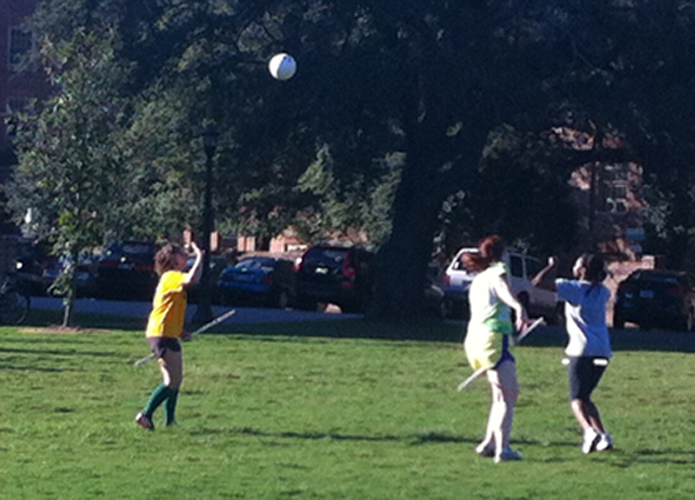The pitch is silent. All stares are fixed forward, 14 pairs of eyes glaring at the enemy with a thirst for vengeance. The whistle blows and 14 brooms race across the field, ducking and weaving, fighting to gain ground. Beaters pick out their next victims, and chasers fly speedily toward the quaffle. Players fall, knocked askew by bludgers, and a thunderous roar erupts from the crowd as the home team scores. The snitch laughs in the distance, taunting the seekers, “Come and get me!”
What seems like a scene from Harry Potter is really just an afternoon at the College of William and Mary. Quidditch has arrived.
Quidditch, the sport played by witches and wizards in the popular Harry Potter book series, has recently hit the muggle — or, non-magical — world with full force. Quidditch, while still a new sport, is certainly growing fast, and since its first official game in October 2005, over 300 colleges and 12 countries have gotten in on the action.
“The current quidditch team here at the College was founded by my friend Sam Meadows ’12 and me last year,” Molly Hilberg ’13, commissioner of the quidditch team, said. “The process involved writing a constitution and presenting it to Student Activities to finally be approved. We wanted to focus mostly on the athletic elements of the game, so that this would be more of a team than a club.”
So what does playing quidditch in a purely muggle world mean? Non-magical quidditch is both similar to and different from the version portrayed in the book series. A muggle quidditch match is comprised of three smaller games, different from the classic one-game matches in the books, but each team is still made up of seven players, each player holding one of four different positions, just like in the series.
Each team has three chasers, whose main goal is to score. This is done by taking the quaffle — in this case, a slightly deflated volleyball — and trying to put it through one of the opponents’ three hoops.
The hoops are guarded by the player called the keeper, whose job resembles that of a soccer goalie.
All the while, two players called beaters are wreaking havoc upon the field. The job of the beaters is to take the ball called the bludger — a dodge ball — and throw it at players of the opposing team, knocking the players off their brooms — often either a household broom or a PVC pipe — causing them to return to their hoops before reentering the game.
The last and most important player is the seeker, whose job is to hunt for and catch the golden snitch, the ball that ends the game. However, due to muggle inhibitions, the golden snitch — traditionally a small, winged ball — is actually portrayed by a player. The snitch dresses in all yellow and attaches a tennis ball inside of a sock to his or her back. The seeker must then capture the sock from the snitch’s back to end the game. Greg Kirwin ’15 is this year’s golden snitch.
“Being the snitch is ridiculous,” Kirwin said. “I get to run wherever I want. I like to run, so it’s a position that suits me. I run with Team Blitz, so this is a good addendum to my running.”
While other players are limited to the field, the snitch may run within a larger limited area — Old Campus, for example, versus just Barksdale Field.
However, quidditch in the muggle world is not without its challenges.
“The hard part is the amount of tiny, little rules. It’s a sport that loves to be quirky,” Hilberg said. “The problem is that quirkiness interferes with gameplay.”
Not to mention the fact that players must constantly run around riding a broom.
“Every part of quidditch is challenging,” Logan Hamilton ’14, one of two team captains, said. “It combines elements of rugby, football and soccer. Plus, you have to do everything one-handed.”
The team not only plays quidditch recreationally but also competitively. Quidditch as a sport is on the rise in the United States; in fact, the International Quidditch Association hosts an annual World Cup, where the two best quidditch teams duke it out for the title of World Cup Champion. The quidditch team at the College is a member of the Virginia Quidditch League, and over of the year-long season will face schools such as the University of Virginia, Christopher Newport University, Virginia Tech and James Madison University, which they are the most excited to challenge.
Team captains and returning members Caroline Lower ’14, a chaser for the team, as well as Hamilton, a chaser and a beater, lead this year’s quidditch team. Both Lower and Hamilton are looking forward to improvements in the newly formed team this year.
“I would like to see our first win this season,” Lower said.
While the competitive aspect of the game is important, many players take away other things from their involvement with the team.
“My dad played football in high school, and growing up, neither me or my brother was very athletic,” Callie Angle ’15, co-comissioner of the team, said. “The first match my dad watched was a very proud moment for him to see his daughter doing something athletic.”
Other players regard their quidditch memories as sweet tastes of victory.
“My best quidditch memory was at the University of Richmond game,” seeker Gladys Shaw ’15 said. “Basically, the snitch grabbed me by my broom and flipped me over it, but I came up from behind him and caught him, getting revenge.”
The team has its first match Sept. 22 at CNU and its first home match Oct. 20.

